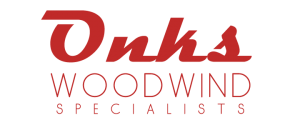Post 16: How much cork grease do I really need?
We receive clarinets and oboes here at Onks Woodwind all the time that have massive amounts of cork grease build up on the tenons. Too much cork grease can be a problem when it oozes up onto the body and gets into the keywork or pads. We also find the cork grease gets on the students’ hands which, in turn, gets all over the instrument and is never cleaned. So here are a few guidelines for cork grease and your clarinet or oboe:
- Always clean tenons first before applying new cork grease. Cork grease attracts dust and dirt which is an abrasive. Adding cork grease on top of old cork grease, dust and dirt will actually make the instrument harder to assemble. You can clean the tenons with a plain, dry paper towel from your kitchen.
- After cleaning, check the tenons first before applying new cork grease to see if you even need cork grease. Here at Onks Woodwind we really strive to fit tenon corks as perfectly as possible, which most of the time eliminates the need for cork grease.
- It is not necessary to apply cork grease to your instrument every time you assemble your instrument!
- After cleaning and checking and if in fact you do need cork grease, apply as sparingly as possible. When I apply cork grease, I put a little on my finger and wipe the cork grease onto the cork. I do not apply directly from the cork grease container, you will apply too much this way! When you are finished applying the cork grease and you can see it on the cork, you have applied too much! You should not be able to see the cork grease on the cork after it has been applied.
What kind of cork grease should you use? Stay away from petroleum-based cork grease! If you are in doubt, do not purchase. If you are in a music store look for cork grease that is labeled synthetic.
As always if you have any questions don’t hesitate to contact us!


